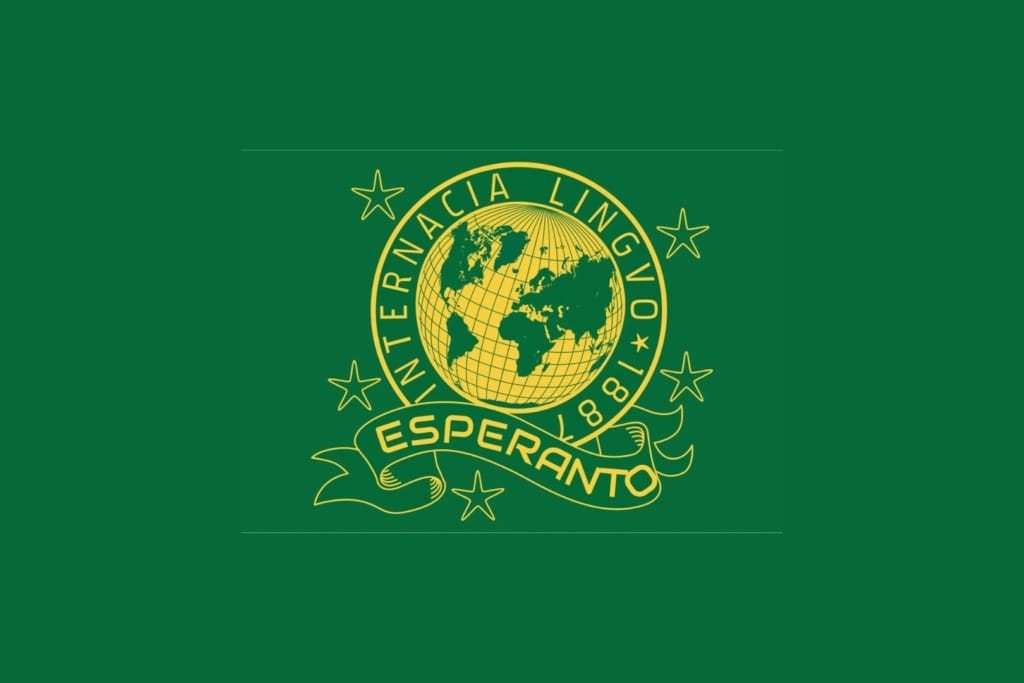
Today, we’ll delve into Esperanto, one of the world’s most well-known yet least-spoken languages. Speaking about Esperanto is, in many ways, speaking about impossible dreams and unfulfilled goals. Why do we say this? Because Esperanto was created to be the universal language shared by all the people on Earth. And, as we know, that dream is far from being realized. But what exactly is Esperanto, and why was this symbolic language born?
In the following lines, we’ll explore more about Esperanto, its origins, and its evolution to the present day. You’ll learn why this language has been banned by totalitarian regimes around the world and why it has become an ideological symbol in recent history. We’ll also take a look at how many people speak Esperanto today.
Ĉu vi pretas malkovri Esperanton? (Are you ready to discover Esperanto?)
Let’s get started!
Is Esperanto an artificial language?
The short answer is yes, Esperanto is an artificial language. The reason is quite simple: Esperanto wasn’t created through the natural evolution of communication. Instead, it was the product of the brilliant mind of a linguist, the Polish Ludwik Lazarz Zamenhof. He lived during the era of the Russian tsars and endured the hardships of Romanov Russia. Zamenhof designed this language with the ambitious goal of making it a universal lingua franca.
In other words, Esperanto was intended to be a shared language spoken in every country and by all the people of Earth. Its primary purpose was to serve as an auxiliary language, meaning it would be spoken alongside the native languages of each region. However, the most defining characteristic that makes Esperanto an artificial language is its very origin. Let’s explore why.
The difference between a “natural” and an “artificial” language
Nearly all the world’s languages have developed as the result of long, complex evolutionary processes. Languages like English, Japanese, or any of the Romance languages emerged through centuries. They have followed intricate social, demographic, geographical, anthropological and even economic factors. These processes “cook” a language slowly over centuries, sometimes millennia, and many are still evolving today.
For this reason, most natural languages are considered living languages. They continue to grow and adapt to the modern era, incorporating new words, adopting slang, and transforming to meet the communication needs of their speakers. They also draw from scientific and artistic expressions, building a literature that can range from colloquial to highly academic. In other words, natural languages often have institutions that study and regulate them.
Artificial languages do not follow evolution
In contrast, artificial languages are created through a closed process, without the input of native speakers. They aren’t the product of the natural evolution of a region or community. Instead, they are constructed with a deliberately designed structure, often as a fixed standard, and are typically resistant to alteration.
We’ll delve deeper into artificial languages in future discussions. However, for now, it’s important to understand that, while they may be deeply thought-out, artificial languages lack the anthropological element. As such, they are disconnected from the culture, development, and history of their speakers.
“A priori” or “a posteriori” languages: What are they?
Linguists classify constructed languages based on two approaches: a priori and a posteriori. In simpler terms, languages can be entirely original creations (a priori) or developed as hybrids from existing languages (a posteriori). Examples of artificial languages include Volapük, Quenya (the language created by J.R.R. Tolkien), Lojban, and Klingon. These were all crafted by individuals or groups for literary or scientific purposes with specific goals in mind.
Interestingly, programming languages or even a musical score could also be considered artificial languages. While this doesn’t diminish their value or importance, it simply defines them.
Without a doubt, Esperanto is an “a posteriori” artificial language—one born from the blending of various languages. Stay tuned, and we’ll explain exactly how.
How was Esperanto created?
The language is, broadly speaking, a language born from the “grammatical refinement” of the most widely spoken languages of the 19th century. In other words, it’s a language that L. L. Zamenhof designed as a way to simplify communication. Zamenhof believed that complex grammatical rules often hindered and even made communication nearly impossible. Even more, between people with different alphabets and grammar systems.
For this reason, Esperanto was intended to be a universal language, one that could be understood by the vast majority of the world’s population.
A crucial point when studying the origins of Esperanto is that L. L. Zamenhof himself was an accomplished polyglot. He spoke Russian, English, German, French, Yiddish, Greek, and Latin fluently. Additionally, he had a basic understanding of Spanish, Italian, and Volapük, an artificial language from the 19th century.
On top of that, he was a physician, which practically required him to read in multiple languages. This may be one of the reasons why he envisioned a language that could simplify the spread of knowledge.
His profession and linguistic expertise provided Zamenhof with the foundation to create a language with a simpler structure and grammar. Let’s take a closer look at how he achieved it.

The rules of Esperanto: The best of every language
Creating Esperanto took Zamenhof more than a decade of study and refinement of the language’s structure. Surprisingly, the greatest challenge he faced was simplifying it. This was because the primary goal of Esperanto was to be easy to learn and use, which, in Zamenhof’s mind, would make it a key ingredient for the language’s global adoption.
At its core, Esperanto draws from the best elements of multiple languages, uniting them into a single language whose main feature is its straightforward construction. Here’s how:
A phonetic language
Esperanto is fundamentally a phonetic language, meaning that every word is pronounced exactly as it is written. This makes it easy to read, regardless of the linguistic background of the speaker.
A Latin alphabet with some “borrowed” features
Esperanto’s alphabet is based on the Latin script, used in languages like English, French, and Spanish. However, it incorporates some elements from Slavic languages, such as the use of diacritics: ĉ, ĝ, ĥ, ĵ, ŝ, and ŭ. These symbols allow for the creation of unique words by combining letters and diacritical marks.
28 letters, 450 morphemes, and 16 grammar rules
The Esperanto alphabet consists of 28 letters, omitting w, q, x, and y. These letters were excluded because they are uncommon in most languages and can complicate pronunciation. They are only used for foreign words, though this is limited to proper nouns.
To speak Esperanto, one only needs to learn about 450 morphemes, which cover nearly the entire language. Compared to English or Spanish, this is much simpler. Furthermore, Esperanto avoids idiomatic expressions or words that fall outside grammatical rules. Colloquialisms and technical terms, which are often exceptions to the rules in other languages, are nonexistent in Esperanto.
One of the most intriguing features of Esperanto is its grammatical simplicity. The language is governed by just 16 rules, most of which focus on constructing words from morphemes and lexemes. This makes Esperanto one of the simplest languages in terms of grammar.
Both an isolating and agglutinative language
Linguists classify Esperanto as both an isolating and an agglutinative language. Let’s clarify, as this can be a bit confusing. Esperanto borrows the simplest word-building methods from other languages.
From isolating languages, like Chinese, it adopts the ability to form complex words by combining morphemes. At the same time, it takes from agglutinative languages, like Japanese or Swahili, the capacity to build words by combining a root and a suffix. For example, simply adding the suffix “-o” forms nouns, while “-a” creates adjectives.
A universal language in the making
These are just some of the fundamental rules and characteristics of Esperanto. They provide us a glimpse into its unique value and its aspiration to be a universal language. Its enthusiasts, numbering over two million worldwide, classify it as one of the fastest languages to learn.
You might be wondering: Is Esperanto still in use today? As you’ll see, this language has sparked strong passions—especially among some of the most infamous dictators and rulers of the last century.

The tumultuous history of Esperanto
What do Hitler, Stalin, and Franco have in common? Besides, of course, being the most infamous dictators of the 20th century. These dictators were all vehement opponents of Esperanto. This stems from one of the most noble characteristics of this language: for many, Esperanto is considered the “Latin of the working class.” At least, that’s how it was perceived by numerous social movements in our recent history.
This language, whose purpose was far removed from politics, was embraced as a common banner by many social movements. Spanish anarchist movements in the first half of the 20th century, as well as global labor movements, adopted Esperanto as their language. In politically diverse countries like the United States and the Soviet Union, Esperanto served as a unifying force.
Thanks to its ease of learning and simple usage, Esperanto was regarded as one of the most effective means of communication, especially among the “most disadvantaged” sectors of society. For a long time, it was seen as more than just a language—it was a statement of intent.
Can Esperanto be a universal language?
Despite its political undertones, UNESCO recognized Esperanto as one of the world’s auxiliary languages. However, it has not been designated as an official language in any country. Even so, this has not stopped a growing number of enthusiasts from falling in love with this fascinating language, which carries a complex and compelling history.
Today, it is estimated that between 500,000 and 2,000,000 people speak Esperanto worldwide. These speakers can be found in countries and regions ranging from India and China to Europe and Latin America. Every day, Esperanto classes attract people eager to learn Zamenhof’s universal language.
Esperanto and technology
In the modern era, many online tools now allow users to translate words from Esperanto into dozens of other languages. For instance, in the Talkao translation apps, Esperanto is one of 125 languages available for translation. Users can discover the meaning of any Esperanto word through the written Talkao translator, as well as learn how to pronounce them using Talkao Translate.
Additionally, the Talkao Dictionary offers countless Esperanto word definitions. In this resource, you can find grammatical forms, correct spellings, and the usage of words across more than a hundred languages.
Learning Esperanto: A journey of connection and freedom
For those who have taken the leap, learning Esperanto is often described as a truly fascinating journey. This language evokes the ideals of freedom and the unity of people through communication. After all, it represents the dream of some of the most idealistic minds in modern history. So…
Kuraĝu paroli Esperanton!








Newsletter